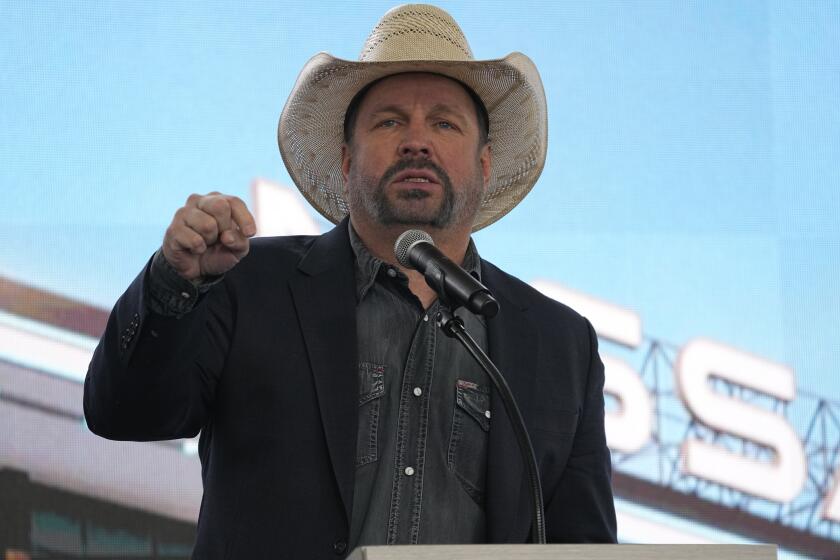MOTOWN OLDIES COMING IN COMPACT DISC FORMAT
Motown Records, already a leader in the compact disc revolution, is about to take two dramatic steps in pursuit of the CD dollar.
Convinced that most CD buyers are as eager for old favorites as new releases, Motown is releasing 84 of its most popular ‘60s and ‘70s albums next month in CD packages that will contain two albums but sell for the price of a single compact disc. CDs carry a $15.98 list price, but are frequently discounted around town to $12.99 or $14.99.
Michael Jackson, Stevie Wonder, Marvin Gaye, Diana Ross, Al Green and Smokey Robinson are among the artists whose early albums will be included in the new merchandising program, Jay Lasker, president of Motown Records, said.
“We’re not talking about highlights of the two albums,” Lasker explained in his office at Motown headquarters on Sunset Boulevard in Hollywood. “We are talking about the complete albums. Technology allows us to put 72 to 74 minutes on a CD--about twice as much music as you find on the average album.”
Equally dramatic is where Motown hopes to sell these--and other--compact discs.
After seeing video manufacturers invade record stores with their prerecorded tapes, Lasker thinks it’s time for record companies to make their product available in video and home electronics stores.
The Federated chain already sells CDs but the discs are rarely found in other home electronics shops. Lasker wants to see them both in videotape rental stores and in hardware chains like Circuit City.
“We expect some of our (traditional record) dealers to be upset when they find out about this and we expect them to continue to be our primary sales source, but the video industry has already made inroads into the record stores and now the video stores are eager to get involved in the compact disc market. They feel this yuppie crowd is coming into their stores and they want anything they can sell to them. MCA (which distributes Motown product) is already beginning to solicit orders.”
Lasker, a 40-year veteran of the music business, is even more bullish than industry estimates that suggest compact discs will account for 25% of the net dollar volume in the record industry by the end of the year. He expects CDs to represent as much as 60% of the industry sales total by 1988.
“The home entertainment industry has gone through a lot of fads, including video games, and most of it just fades away,” Lasker said. “But compact discs are different.
“You get an idea of how fast this whole thing is growing when you look at the new Lionel Richie album. The initial CD orders for his last album (in 1983) was 10,000. The advance CD orders for the new one is 500,000 .”
The enormous public demand for CD releases has allowed record companies to be passive about CDs.
Rather than design special, budget-conscious collections that take advantage of the longer playing time available on CDs, most labels have been content to simply put their latest releases in CD and supplement them with a few older titles.
The result is that CD fans generally have to pay $12 to $16 for the same greatest-hits package that would cost them $6 to $9 in conventional LP or cassette configurations--sometimes getting as little as 25 to 35 minutes of music.
Motown has already begun attacking this system with a CD greatest-hits series that averages around 60 minutes of music per artist. That series, known as “Compact Command Performances,” includes almost a dozen releases and involves virtually all the Motown stars, including Marvin Gaye, the Jackson 5, Diana Ross, the Supremes and Smokey Robinson & the Miracles.
The new two-for-one series will include some of Motown’s most prized collections. One Marvin Gaye package, for instance, will feature both the “What’s Going On” and “Let’s Get It On” albums. A Smokey Robinson & the Miracles CD includes the “Going to a Go-Go” and “The Tears of a Clown” albums. One Stevie Wonder CD will offer both the “My Cherie Amour” album and the “Signed, Sealed and Delivered” LP, while a second features “For Once in My Life” and “Up-Tight.”
Among other artists represented in the series: the Supremes, the Jackson 5, the Four Tops, Gladys Knight, Grover Washington Jr., Rick James, the Commodores, the Temptations, Edwin Starr, Mary Wells and Junior Walker.
Why haven’t other record companies been more aggressive in designing special CD packages?
“Some of the big (record) companies are so tied up with other things that they don’t really look ahead on something until it hits them in the face,” Lasker said. “But I think they’ll soon be following along. Within a year, everyone will have these packages.”
Laker said he believes the affluent, music-conscious yuppie audience responsible for a high percentage of CD purchases is as interested--if not more interested--in catalogue albums as in the latest hits.
“The CD audience is older and they are in effect replacing their record collection with CDs--not every album, but their favorite ones. Once they buy a CD player, that LP is like an old-hat thing. . . . The music sounds terrible by comparison. We are in an especially strong position here because that yuppie audience grew up on Motown music.
“Look at the success of that ‘Big Chill’ movie. Our sound-track album sold 3 million copies.”
Lasker said the main financial consideration involved in putting two albums on a single disc is the publishing costs. “The cost of the making the CD disc and the artist royalties are the same, but the songwriting royalties double. You have to pay five cents a song to the publisher, which means about 50 cents for a 10-song album. With two albums, you’re talking an extra 45 to 50 cents.”
But, he stressed, that figure is negotiable.
“You explain to the publisher that these sales are ‘extra’ . . . that they’ll be getting more money in the long run by charging us only four cents per song, which makes it possible to put out the CD,” he explained. “Most publishers are going to say to you, ‘Fine, we want to be there,’ because it’s four cents more (per song) than they would have gotten.”
Lasker--who ran the Dunhill and ABC record labels before joining Motown in 1980--said the label is backing the new two-for-one CD campaign with a $1.5-million ad push and expects about $10 million in initial orders. He estimates the first packages should be in the stores by Aug. 18.
More to Read
The biggest entertainment stories
Get our big stories about Hollywood, film, television, music, arts, culture and more right in your inbox as soon as they publish.
You may occasionally receive promotional content from the Los Angeles Times.










